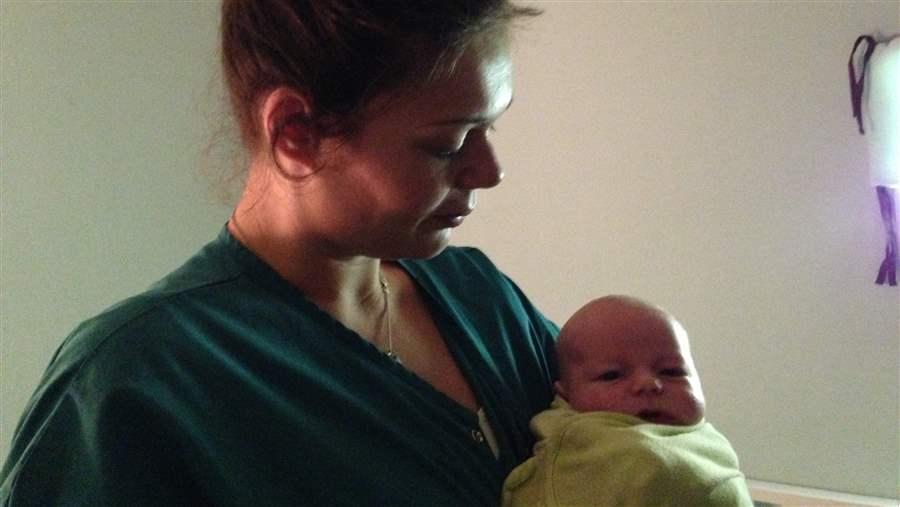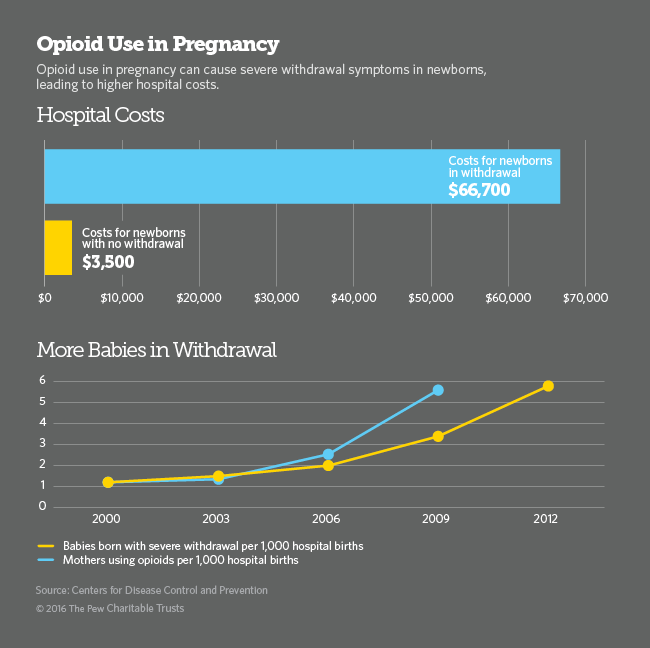How Could I Raise Money to Help the Drug Addicted Babies?

Whitney Hensley holds her son, Liam, at Lily's Place, a medical facility in Huntington, Westward Virginia, where newborns with drug withdrawal symptoms are cared for after they leave the hospital. As the opioid epidemic progresses, the need for infant care is exploding.
© The Pew Charitable Trusts
HUNTINGTON, W.Va. — Before hospitals in the rest of the country started seeing a surge in the number of infants born with astringent drug withdrawal symptoms, this boondocks of l,000 was already facing a crisis.
In 2010, babies born to mothers using heroin were filling up so many beds in the newborn intensive care unit of measurement at the city's master hospital that little space was left for babies with other life-threatening conditions.
The nurses who cared for these agitated and often comfortless infants knew in that location was a better and less costly style to help newborns through the painful, weekslong process of drug withdrawal.
Past 2012, they had created a separate newborn therapy unit just for babies in withdrawal. Because their handling didn't crave the same high-tech equipment needed in an intensive care unit, it was well-nigh half the toll of neonatal intensive care, according to Dr. Sean Loudin, who heads the new unit of measurement at Cabell Huntington Hospital.
The next footstep was to create an infant recovery center exterior the infirmary where newborns could be taken as soon as information technology was safe to go out the infirmary, usually within two weeks. Non only would it free upwards beds for other newborns who need intensive care, it would be tailored to the needs of infants in drug withdrawal, and their parents.
The facility, known as Lily's Place, opened its doors Oct. 1, 2014, in a one-story building that had been a podiatry do in downtown Huntington. The city, West Virginia'due south 2d largest, is at the epicenter of the country's opioid epidemic, with an overdose death rate that is nearly 10 times the national average.
Staffed by the same doctor and team of nurses who treat drug exposed babies in the hospital, plus a social worker, authoritative staff and additional nurses and assistants, Lily's Identify is a transitional care centre where parents tin visit their babies throughout the day and occasionally stay overnight before taking them dwelling.
Infants receive the same kind of medical handling for their withdrawal symptoms as they do in the hospital: small doses of the long-acting opioid methadone to gradually wean them from their drug dependence.
Since information technology opened, 135 infants have spent from two to six weeks at Lily'south Place. And the center has go a model for communities in the residual of the land that are experiencing the same kind of growth in drug exposed newborns as Huntington.
"Lily's Place is a terrific model," said Dr. Edward McCabe, chief medical officer at the March of Dimes. "The care for these babies is very different than the care for a small premature infant or one with a nascency defect. Non to minimize what they're going through, but these babies don't need to be in a high-cost intensive care setting," he said.
Rebecca Crowder, the facility'due south executive director, said Lily'south Place has talked to at to the lowest degree 30 groups across the country that want to replicate what the centre has done, including organizations from other communities in Due west Virginia and groups from Arizona, California, Colorado, Maryland, New Jersey, Ohio, Oregon and Virginia. Uttermost along is a facility called Brigid's Path near Dayton, Ohio, that is slated to open in April 2017.

Growing Need
Nationwide, the number of pregnant women using heroin, prescription opioids or addiction treatment medications methadone or buprenorphine has increased more than fivefold since 2000. With increased drug apply, the number of babies born with severe withdrawal symptoms has also spiraled, leaving hospitals scrambling to find better ways to care for this burgeoning population of drug addicted newborns.
Until the opioid epidemic began spreading across the land nigh eight years ago, most hospitals saw merely one or ii cases a year of what is known equally neonatal abstinence syndrome. Now, a infant is born suffering from opioid withdrawal every 25 minutes in the U.S., according to the National Establish on Drug Abuse.
When a pregnant woman uses drugs or booze during pregnancy, some of the substances laissez passer through the placenta to the baby. In many just not all cases, exposure to opioids, alcohol and other drugs during pregnancy can cause the fetus to develop concrete drug dependence. When the umbilical cord is cutting at nativity, the newborn is abruptly disconnected from its supply of drugs and tin suffer withdrawal symptoms, much like adults do.
Symptoms include excessive crying, sleep issues, diarrhea, vomiting, seizures and musculus cramps. The treatment is small, gradually tapered doses of either morphine or methadone over three to six weeks.
The price of caring for a drug exposed newborn in a hospital is nearly 20 times the price of hospital treat a healthy babe. The cost of caring for newborns at Lily'due south Identify is 1-fifth the daily rate of a hospital intensive intendance unit, Loudin said.
National Models
The concept for Lily'southward Place came from Kent, Washington, where a similar facility, the Pediatric Acting Intendance Heart, was started in 1990, during the cocaine epidemic.
Its founder and executive director, Barbara Drennen, began caring for infants born to mothers who were abusing drugs by becoming a foster parent. Doctors and nurses visited her domicile to care for the starting time four babies she took in.
Later, she said, "the hospitals asked me to provide the same kind of intendance on a larger calibration." Today she runs a facility, funded by state grants and private donations, that cares for up to 20 newborns in drug withdrawal.
Drennen said she learned how to intendance for the youngest victims of drug abuse from an earlier pioneer, in New York City. Clara Hale, who died in 1992, took in abandoned and orphaned newborns, starting in 1969, and cared for them in her dwelling house.
But the founders of Lily's Place wanted to do something different in Huntington. Instead of caring for orphaned or abandoned babies and those taken from parents by child protective services, they wanted to create a transitional therapy center that ultimately would allow parents to intendance for their babies at home.
Past the end of this month, Crowder said the Lily'south Identify website would offer a guidebook to help ease the time-consuming procedure of explaining to others how they created the facility. It will, for example, explain how to create a nonprofit and raise funds, and how to comply with building codes and encounter staffing requirements to be licensed as a medical facility, she said.
A Soothing Identify
Anyone who has walked through the doors of Lily'south Identify knows it is dissimilar any medical facility they've e'er visited. There is no hustle hurry and no whirring and beeping technology. The lights are dimmed and the staff speaks in hushed tones. Parents look in silence to visit their babies.
Each baby or ready of twins is cared for in one of 15 individual nurseries with a crib, changing table and rocking chair. The rooms, all cheerfully decorated, allow parents to visit and hold or stone their babies in individual, without disturbing the other infants.
While the babies are cared for at Lily'south Identify, a staff social worker helps parents and their extended families prepare their domicile to become a condom and nurturing place to care for their new babies, who typically proceed to suffer from balmy withdrawal symptoms for several months.
Infants in drug withdrawal tin exist fussy and more than difficult to care for than other infants, staff social worker Angela Davis explained, and then each family member is trained on how to care for their baby. Davis also helps parents find jobs, better housing, financial help and addiction treatment.
One time their symptoms subside and they no longer need to be dosed with methadone, the infants are ready to get home with their parents.
A staff social worker visits the dwelling house a calendar week afterward, to make sure the parents are coping well with their new baby. Visits are then cutting to once a month, and so in one case every 3 months, or as needed.
Parents are free to call nurses at Lily'southward Place, who are on duty 24/7, or stop in for a visit. In addition, a pediatric neurologist holds clinics for parents twice a month.
With a bare-bones budget of $1 meg, Crowder said Lily'south Identify relies on volunteer work and local donations, which keep to pour in. The building was donated by a Huntington family, and local residents take paid for almost of the supplies, including diapers, furniture and apparel, she said.
Regulatory Hurdles
When they were in the planning phase, the founders of Lily'south Place sought the communication of U.South. Rep. Evan Jenkins, a Republican, who at the time represented Huntington in the state Legislature.
Jenkins helped them get temporary approval to operate as a medical facility, nether a land pilot program that initially classified them as a long-term care center for the elderly and the disabled. Later on, he backed a country law that created a new licensing designation for Lily's Place and others similar it.
At present he's negotiating with the U.S. Centers for Medicare and Medicaid Services to get the needed approval for Lily'south Place to receive reimbursement through Medicaid, the federal-state health insurance plan for the poor.
Jenkins was elected to the U.S. Congress in 2014. He supported a recently enacted federal law, the Comprehensive Recovery and Addiction Treatment Act, that includes a provision calling on the federal regime to shine the regulatory path for other communities that wish to open facilities like Lily'southward Place.
Information technology'due south in the regime's involvement, he said, to let other communities to develop similar facilities. It would free up hospital intensive intendance units and save taxpayers a lot of money.
Source: https://www.pewtrusts.org/research-and-analysis/blogs/stateline/2016/10/05/caring-for-the-opioid-epidemics-youngest-victims
0 Response to "How Could I Raise Money to Help the Drug Addicted Babies?"
Post a Comment